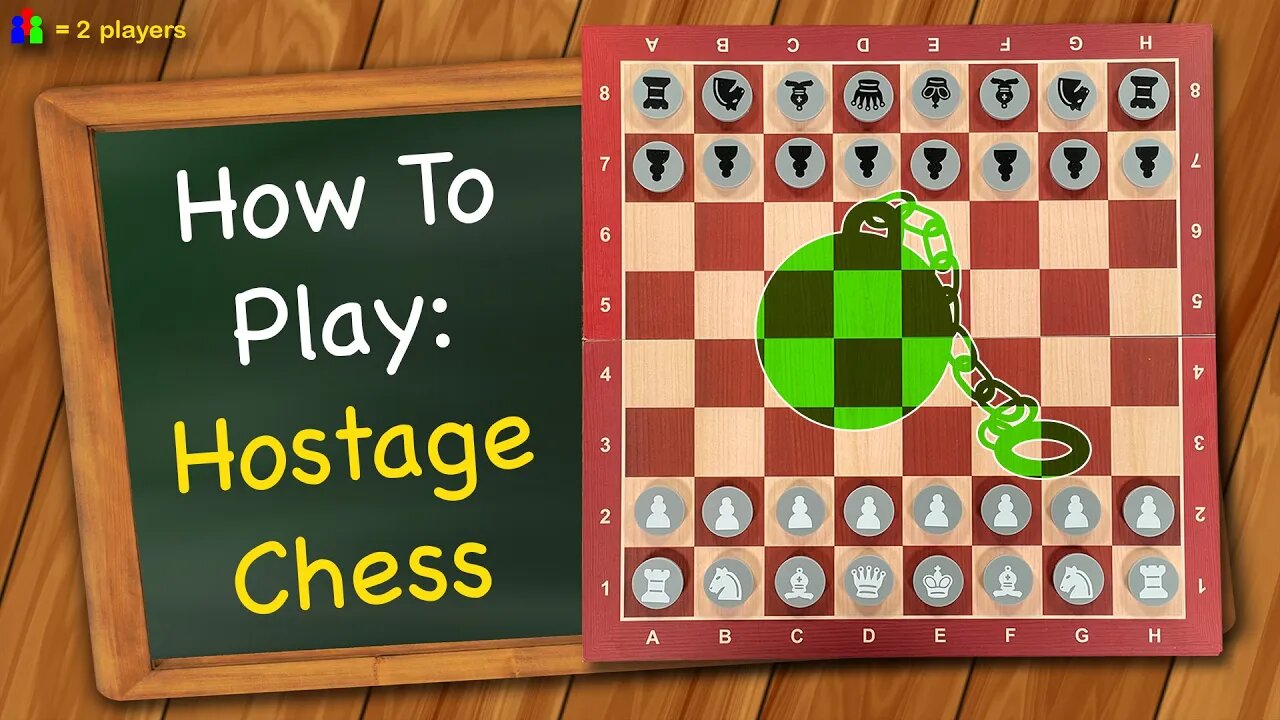Premium Only Content

How to play Hostage Chess
Learn the rules to the Chess Variant: Hostage Chess - This video has no distractions, just the rules. For a refresher of the original Chess rules, check out this video: https://youtu.be/fKxG8KjH1Qg
Play chess online for free here:
https://link.triplesgames.com/Play-Chess-Online
(As an chess.com affiliate we earn from qualifying subscriptions)
Buy Double-Sided Chess Discs here: https://buy.triplesgames.com/DoubleSidedChessDiscs
Don't own the game? Buy it here:
USA - https://amzn.to/2RMQwtO
Canada - https://amzn.to/3gCiKDV
UK - https://amzn.to/3Dmuhkx
Australia - https://amzn.to/3kuDJK0
(These Amazon Affiliate links directly supports me)
RULES:
Each player has a prison on the right side of their board and an airfield on the left. Whenever you capture a piece, you place that piece in your prison. On your turn, instead of making a normal move, you may perform a hostage exchange. Transfer one of your prisoners to your opponent’s airfield to take an appropriate piece from their prison and place that piece on any empty space on the board, this is called dropping a piece. The piece transferred must be of equal or greater value than the piece released from prison. The relative piece values are: queen is the highest, followed by rook, then bishop and knight are of the same level, with pawn the lowest value. A hostage exchange may not be refused by your opponent.
After you drop the released prisoner, your turn ends. On your turn instead of moving, you may drop any piece that is in your airfield. You may drop pieces to any empty space on the board. You may drop a piece to give check or checkmate. You may not drop a pawn on the 1st or last row. If you drop a pawn on the 2nd row, that pawn is allowed the 2 step move option. A dropped pawn may not be captured via En passant immediately after the drop. A dropped rook on a rook starting square can be used in castling so long as all the normal castling requirements are followed. You may drop a bishop on any space.
Your pawns may only be promoted to pieces higher than a pawn if that piece is available in your opponent’s prison. You pick which piece to promote to and replace the pawn with that piece in your opponent’s prison. Captured promoted pieces are placed in the prison and treated as that piece.
If there are no pieces available to promote to, then the pawn may not advance to the 8th row. Furthermore, if your opponent’s king is diagonally in front of the pawn and there is no available piece to promote to, then the king is not in check as the pawn is unable to advance to the 8th row. However, you opponent would also not be allowed to capture any piece that your pawn could promote to as that would immediately put the player in self-check.
The first player to checkmate their opponent, wins.
-
![I'm Grand (Master) [Official Music Video] - Triple S Games & Sheet Music Boss](https://1a-1791.com/video/s8/1/9/v/q/d/9vqdo.0kob-small-Im-Grand-Master-Official-Mu.jpg) 3:36
3:36
Triple S Games
1 year ago $0.07 earnedI'm Grand (Master) [Official Music Video] - Triple S Games & Sheet Music Boss
1.75K4 -
 1:09:15
1:09:15
Precision Rifle Network
1 day agoS4E3 Guns & Grub - Trump a new era for gun rights?
87K9 -
 1:05:31
1:05:31
Glenn Greenwald
11 hours agoSection 702 Warrantless Surveillance Ruled Unconstitutional: Press Freedom Advocate Seth Stern Explains; The Rise of Unions & the Impact of Trump's Populism with Author Eric Blanc | SYSTEM UPDATE #395
118K98 -
 1:01:13
1:01:13
The Amber May Show
9 hours ago $4.59 earnedWomen Of Rumble | Amber, Kelly and Wendy Wild
51.7K5 -
 1:16:38
1:16:38
Josh Pate's College Football Show
11 hours ago $2.58 earnedCFP Title Viewership | JP Poll Under Attack | Bama & Oregon Season Grades | Most To Prove In 2025?
48.8K -
 5:10:59
5:10:59
VOPUSARADIO
15 hours agoPOLITI-SHOCK! "THE TIDE IS TURNING"! 3 SPECIAL GUESTS JOINING US TONIGHT!
32.5K2 -
 52:47
52:47
Kimberly Guilfoyle
13 hours agoDismantling DEI Once and For All, Live with Tyler O’Neil & Eric Deters | Ep.190
98.4K42 -
 1:34:59
1:34:59
Redacted News
13 hours agoBREAKING! TRUMP SIGNS ORDER TO RELEASE JFK FILES, CIA IS FURIOUS | REDACTED NEWS
226K381 -
 1:36:09
1:36:09
Benny Johnson
13 hours ago🚨WATCH: President Trump Declassifies JFK, RFK, MLK Files LIVE Right Now in Oval Office, History Now
171K331 -
 2:02:09
2:02:09
Common Threads
11 hours agoLIVE DEBATE: Will Democrats Roll Over or Fight Back?
31.2K1